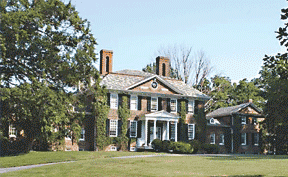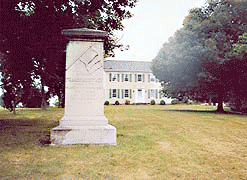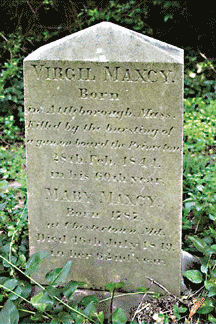 |
|||||||||||
|
|||||||||||
|
|||||||||||
Living HistoryWilliam and Patrice Chaney at Home in Maryland’s Pastby Margaret Tearman, Bay Weekly Staff Writer
Surrounded by a wealth of American history in Bay Country, we are accustomed to the sometimes dubious claim George Washington slept here! There’s nothing dubious in the claim of the Chaneys of Galesville. Two of their homes — Terra Rubra and Tulip Hill — were often visited by our first president and by Robert E. Lee. And a slew of other people right out of Maryland’s history books. Born into HistoryWilliam ‘Billy’ and Patrice Chaney have a particular affection for history and old houses. They don’t just tour or visit historic homes. They buy them, restore them, cherish them and make them their family home. Self-described “minor historian” Billy Chaney has been possessed by a life-long interest in history. Perhaps he was born into it. Some say he was born 100 years too late, that he fits better into the 19th century than the 21st. As a Chaney, he can trace his family history in Maryland back to the 17th century. Archaeologists have found the footprint of the original Chaney house, circa 1649, in Riva. A casual conversation with Chaney quickly turns into a history lesson. “I am descended from Robert E. Lee on both sides of my family,” Billy says. Cousins “Richard Henry Lee and Francis Lightfoot Lee were the only brothers who signed the Declaration of Independence. Did you know that?” His home is filled with historical memorabilia: framed letters from prominent Americans and historical artifacts, including Robert E. Lee’s hatband. Most of the memorabilia was purchased by Chaney from private collectors or at auction. The rooms are furnished with antiques from around the world. His love — no, make that addiction — to history consumes him. Chaney’s wife, Patrice, shares his passion for history. “We have always lived in old houses,” she says. One of their old houses was Lothian, circa 1801, built by one of Chaney’s ancestors. “We both love living in a home knowing it has a part in our country’s history.” The Chaneys have lovingly restored their old houses with meticulous attention to detail. Billy is frustrated by historically incorrect — and what he considers unnecessary — renovations. Standing in front of his current home, the magnificent Tulip Hill in Galesville, he scowls at the long circular driveway leading up to the 250-year-old manor. A previous owner “upgraded” the stone driveway to asphalt. Billy would like to “tear it all up and replace it with stone. That’s the way it was and the way it should be.” Terra RubraIn 1998, the Chaney’s purchased and began restoration of Terra Rubra, a two-story, four-bedroom Georgian farmhouse in Carroll County. Terra Rubra was built in the mid 18th century, but it was the home’s past residents that sealed the deal: It is the birthplace and childhood home of Francis Scott Key, the composer of The Star-Spangled Banner. He was the son of John Ross Key, a distinguished Revolutionary War soldier. The Keys were known for their hospitality, and in July 1791, President George Washington visited their home on his way to Philadelphia. Terra Rubra, Latin for red earth, was named for Carroll County’s red clay soil. The original estate was 2,800 acres. Today the land has been reduced to 150 acres. Still, it’s removed from 21st century distractions. “No cars ever go by,” Chaney says. “It’s so quiet, just beautiful.” To Chaney’s horror, prior owners had modernized the historic house. “We had to completely restore the house,” Chaney grimaces. “Every room had been painted with modern colors — like purple.” Carpeting had been installed throughout the house; this historic misstep ultimately proved to be a blessing as the carpet protected much of the original hardwood floors. The Chaneys spent two years restoring the home, transforming it back to its 1850s’ state. “I got the house and the grounds back the way it was, and it made me feel good,” Chaney says. “It really is a national treasure.” The house has been on the National Register of Historic Places since 1978. As much as the Chaneys love old houses, they both say it is the people who built the houses and who raised families within the walls they cherish most. On a wall in Terra Rubra hangs a portrait of Key. “Every morning I would walk by that portrait,” says Billy, “and say good morning Mr. Key.”
Tulip HillWith the job of restoring Terra Rubra behind them, the Chaneys found themselves missing Southern Maryland and their grandchildren. They found another historic gem, Tulip Hill, in Galesville. Classed as one of the finest historical homes in Maryland, Tulip Hill was built in 1756 by Samuel Galloway, a wealthy ship builder and trader. The Georgian mansion stands on land patented as Poplar Knowle in 1659 by Richard Talbott. The property was first known as Poplar Hill for the massive poplar trees that sailors on Cox Creek used as navigational landmarks. Galloway bought the property in 1755 and began construction of the home he named Tulip Hill. Originally eight rooms with a large central hallway and sweeping staircase, Tulip Hill was extended by Galloway’s son. Two wings were connected to the main house by hyphens, short halls similar to an enclosed breezeway. The finished house is just under 8,000 square feet. There are 12 rooms, not including bathrooms, and six sets of stairs. One of those stairways, in a second-floor bedroom in the main house, leads to the attic with its massive hand-hewn timbers. Another set of stairs, more like a steep ladder, leads to a door in the attic roof and a small widow’s walk. From this perch, sailboats on Cox Creek look like toy boats. At 250 years old, the floors barely sag and the doors swing shut with ease. “This house is well designed, well built,” says Chaney. “My summer electric bills, even with air conditioning put in by another owner, are only about $200 a month.” Every room has a working fireplace, making the large home cozy on cold winter months, too. Tulip Hill is the second Chaney home that boasts visits from the nation’s first president: George Washington’s diary contains entries about his many visits to his friend, “Mr. Samuel Galloway.” Chaney’s ancestor Robert E. Lee was also a later visitor. “I didn’t know Lee stayed here when I bought the house,” says Chaney. “I found out about it while I was researching the history of the house.” The Lee connection continues. While researching the history of Tulip Hill, Chaney learned the two distinctive arched chimneys on the main house were designed after the chimneys at Lee’s birthplace, Stratford Hall in Virginia. The 90-acre property holds surprises around every corner. Gardens of perennial flowers and huge Oregon grape hollies abound. There is a Victorian-era glass house, still partially obscured by vines and small trees, amazingly preserved. Just past the glass house is an ornate Victorian iron fence, dated 1866. It leads into the estate’s cemetery. The cemetery contains the Galloway family burial vault, including the remains of wife Ann Chew, who died the year her home was completed. Another past resident who played a part in American history is buried in that cemetery; Virgil Maxcy of Maryland, U.S. diplomat to Belgium from 1838 to 1842 was killed in 1844 while aboard the USS Princeton testing a new cannon that accidentally misfired. This house didn’t need restoration. Former owner Morgan Wayson had done most of the work, adding central heat and air conditioning. Billy and Patrice “fixed up the bathrooms and the kitchen.” There is still work to be done, but there isn’t any rush. The Chaneys consider themselves “caretakers” of their historic homes. “I don’t do any restorations quick,” Chaney says. “When you do something, you’ve got to think about it for a while. Then you do it right.” Moving OnThese houses may be historic gems, full of museum quality art, artifacts and furnishings, but first and foremost they are homes for the Chaney family. Chaney homes are filled with delighted squeals as grandchildren slide down the banisters, climb up twisting narrow staircases and plop down on rugs to play. The family dog greets visitors at the front door, and the cat regularly perches on an antique table. But amidst the cacophony of family life is unspoken respect for the history of those who came before. There is unmistakable pride in the knowledge they are all caretakers of a piece of American history. By the time you read this story, the sale of Terra Rubra will likely be complete. Two historic homes are too much to handle. And Tulip Hill? “This is a lot of house for just two people,” Patrice says. They are considering selling it, too. What next? Bill Chaney pauses, then smiles. “I think I’d like to go spend some time in Jerusalem, maybe doing some church work.” Don’t be surprised if the Chaneys take their love of history and historic houses with them to the Holy City. Perhaps some day they can add to their list Jesus slept here.
|
|||||||||||
|
|||||||||||
|
|
|||||||||||
|
© COPYRIGHT 2007 by New Bay Enterprises, Inc. All rights reserved.
|
|||||||||||



